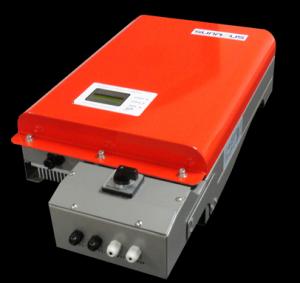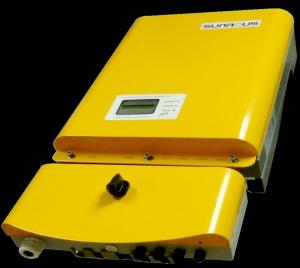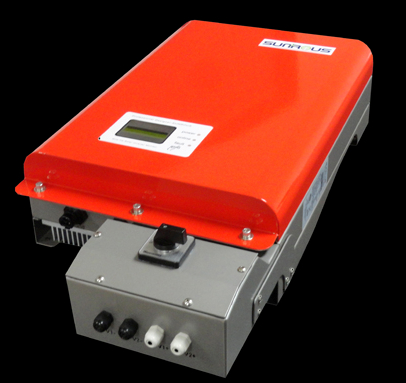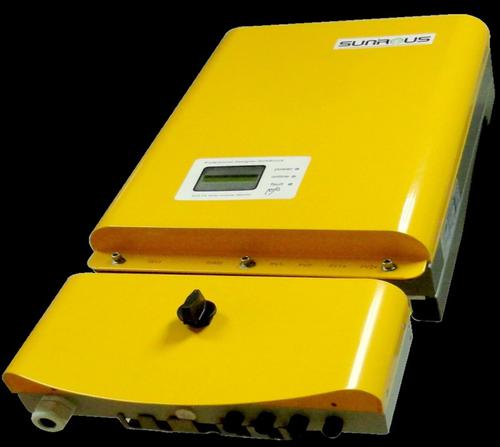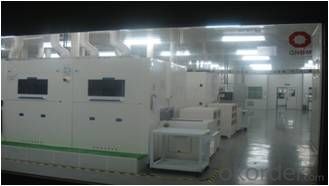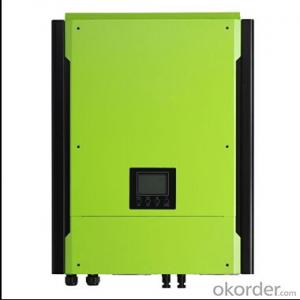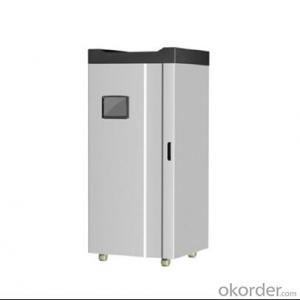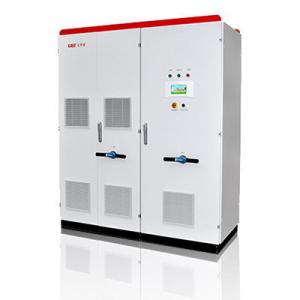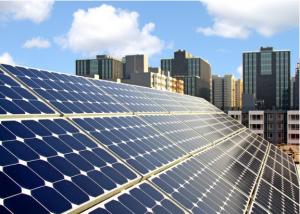Solar Inverter 30kw High Frequency Transformer Isolation PV Grid-Tied Inverter
- Loading Port:
- Shanghai
- Payment Terms:
- TT or LC
- Min Order Qty:
- 50 mm
- Supply Capability:
- 1000 mm/month
OKorder Service Pledge
OKorder Financial Service
You Might Also Like
· The highest effciency achieves 98%
· Wide input Voltage range
· Adopt connectors type cable connection, Easy operation and installation
· Best tracking effciency with OptiTrac MPP control
· operating temperature range -25 ℃ to + 55℃
· High reliability due to complete protection function
· Anti-theft protection
· Plug-in grounding
HF series 1.5kw — 5.0kw
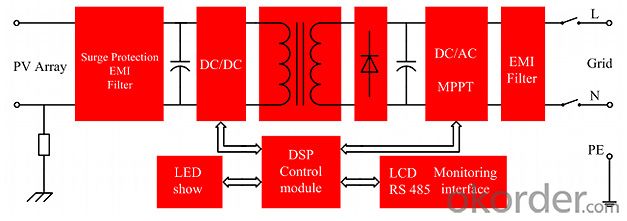
High frequency transformer isolation is the main feature of our production, which make Installation easier due to the reduced weight and higher conversion effciency because of omitting Low frequency transformer. The wide input voltage range from 180 to 600volt gives you extraordinary fexibility for you system design. Not need to set graphic display and RS485 communication system make the devices highly user-friendly.
This product can by multi-level parallel combination for 6kw to 20kw needed any power grade HF series technical parameter.
parameters:
GT1.5-ZX-01/HF | GT2.0-ZX-01/HF | GT2.5-ZX-01/HF | GT3.0-ZX-01/HF | GT4.0-ZX-01/HF | GT5.0-ZX-01/HF | |
Input(DC) | ||||||
Max.DC Power | 1600W | 2100W | 2650W | 3150W | 4200W | 5200W |
Max.DC Voltage | 600V | |||||
PV Voltage range, MPPT | 150V ~ 550V | 150V ~ 550V | ||||
Max.input current | 10.0A | 14.0A | 16.0A | 20.0A | 25.0A | 30.0A |
Number of MPP trackers | 1 | |||||
Max.number of strings (parallel) | 1 | 1 | 2 | 2 | 3 | 3 |
Output(AC) | ||||||
Nominal AC power / | 1500W | 2000W | 2500W | 3000W | 4000W | 5000W |
Max.output current | 13.0A/7.0A | 17.0A/9.0A | 21.0A/12.0A | 25.0A/14.0A | 21.0A | 30.0A |
Nominal AC Voltage / range | 102-138Vac/180-264Vac | 180-270Vac | ||||
AC grid frequency / range | 47.5-51.5Hz / 59.3-60.5Hz | |||||
Power factor at rated power | 1 | |||||
THD | < 3% | |||||
AC connection | Single-phase | |||||
Efficiency | ||||||
Max. efficiency/Californian efficiency | > 98.0% / > 97.0% | |||||
MPP adaptation efficiency | > 99.0% | |||||
Protection devices | ||||||
DC reverse polarity protection | √ | |||||
AC short-circuit protection | √ | |||||
Ground fault monitoring | √ | |||||
Grid monitoring | √ | |||||
Output Transient Voltage Suppression | √ | |||||
Over load | √ | |||||
Anti-islanding | √ | |||||
General data | ||||||
Dimensions (W/ H / D) in mm | 350 / 560 / 160 | 370 / 540 / 185 | ||||
Weight(Kg) | 16 | 19 | 23 | |||
Operating temperature range | -25 ~ +60℃ | |||||
Storage temperature range | -40 ~ +70℃ | |||||
Ambient humidity | 0 ~ 100% | |||||
Consumption (night) | < 0.5W | |||||
Topology | HF-transformer galvanic isolation | |||||
Cooling concept | Convection | |||||
Enclosure type | IP65 / NEMA 3R | |||||
Features | ||||||
DC connection: PV special connector | √ | |||||
AC connection: connector | √ | |||||
LCD display & Backlit | √ | |||||
LED display | √ | |||||
Interfaces: RS485 | √ | |||||
Warranty: 10 years | √ | |||||
Certificates & approvals | G83 / G59 / TUV / SAA / ETL / JET/ CE | |||||
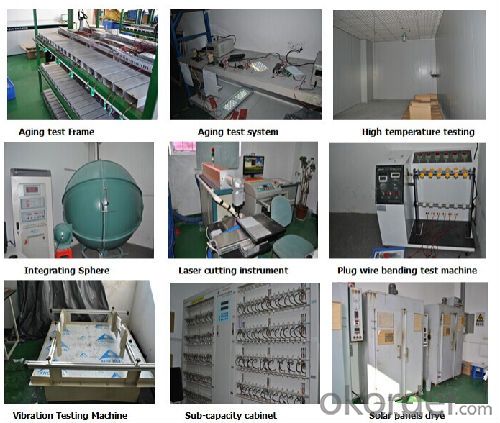

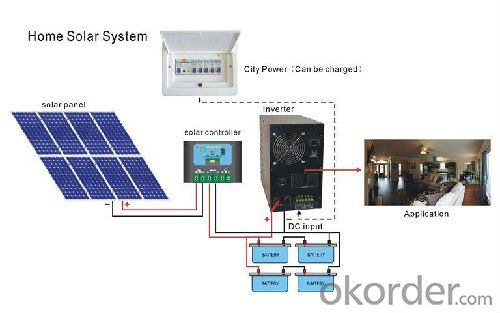
FAQ
Q1 : Do you accept OEM/ODM?
ODM&OEM are warmly welcomed !!!
Q2 : what’s your payment?
a)We can accept payment terms of T/T, Western Union, PayPal
Samples and trial order accept PayPal ,T/T & Western Union. normal order accept T/T &Western Union
b) 30% ADVANCE DEPOSIT after buyer's confirmed payment, the balance should be paid before shipping when goods are ready.
- Q: Are there any government regulations or certifications for solar inverters?
- Yes, there are government regulations and certifications for solar inverters. In many countries, solar inverters must comply with specific standards and regulations set by government bodies. Additionally, various certifications such as International Electrotechnical Commission (IEC) standards, UL listing, and CE marking are commonly required to ensure the safety, performance, and interoperability of solar inverters.
- Q: What is the difference between a string inverter and a micro inverter?
- A string inverter is a type of solar inverter that is connected to a series of solar panels, converting the DC power produced by the panels into AC power for use in homes or businesses. A micro inverter, on the other hand, is installed on each individual solar panel, converting the DC power into AC power at the panel level. The main difference between the two is that a string inverter handles the entire string of panels, while a micro inverter operates on a per-panel basis. This means that micro inverters offer advantages such as increased energy production, better module-level monitoring, and improved system flexibility, but they can also be more expensive and complex to install compared to string inverters.
- Q: Can a solar inverter be used with other renewable energy sources like wind or hydro power?
- Yes, a solar inverter can be used with other renewable energy sources like wind or hydro power. Inverters are designed to convert the direct current (DC) produced by renewable energy sources into alternating current (AC) that can be used to power homes and businesses. So, by connecting wind turbines or hydroelectric generators to a solar inverter, the generated DC power can be efficiently converted and integrated into the electrical grid or used for various applications.
- Q: How does a solar inverter handle voltage and frequency variations caused by sudden load changes?
- A solar inverter is designed to handle voltage and frequency variations caused by sudden load changes in an efficient and reliable manner. When sudden load changes occur, the solar inverter employs various control mechanisms to regulate and stabilize the voltage and frequency output. Firstly, the inverter continuously monitors the voltage and frequency of the incoming solar power. If there are any variations due to sudden load changes, the inverter adjusts its internal control systems accordingly. It uses advanced power electronics and control algorithms to maintain the voltage and frequency within the desired range. To handle voltage variations caused by sudden load changes, the solar inverter employs a technique called voltage regulation. It automatically adjusts the output voltage by either boosting or reducing it as needed. This ensures that the inverter provides a stable and consistent voltage supply to the load, preventing any damage or malfunction. Similarly, to handle frequency variations caused by sudden load changes, the solar inverter employs a technique called frequency regulation. It adjusts the output frequency to match the grid frequency or the specified frequency requirements. By maintaining the desired frequency, the inverter ensures compatibility and synchronization with the grid or other connected devices. In addition to voltage and frequency regulation, solar inverters also have protective features to handle sudden load changes. They have built-in overload protection mechanisms that can detect excessive loads and prevent any damage to the inverter or the connected devices. These protective features can include overcurrent protection, short-circuit protection, and temperature monitoring. Overall, a solar inverter is designed to handle voltage and frequency variations caused by sudden load changes through its voltage and frequency regulation capabilities, as well as its protective features. These technologies ensure stable and reliable operation, allowing the inverter to efficiently adapt to changing load conditions while maintaining the integrity of the power supply.
- Q: Can a solar inverter be used with a solar-powered backup generator?
- Yes, a solar inverter can be used with a solar-powered backup generator. The solar inverter is responsible for converting the direct current (DC) generated by the solar panels into alternating current (AC) that can be used to power household appliances and electrical devices. When connected to a solar-powered backup generator, the solar inverter can efficiently regulate and distribute the electricity produced by the generator, providing a reliable and sustainable source of power.
- Q: Can a solar inverter be used in areas with high dust and dirt accumulation?
- Yes, it is possible to use a solar inverter in areas where there is a high accumulation of dust and dirt. However, it is important to take specific precautions and maintenance measures to guarantee its proper operation. Over time, dust and dirt can build up on the surface of the solar panels, causing a decrease in their efficiency. This can also have an impact on the performance of the solar inverter, as it relies on the energy produced by the solar panels. To minimize the impact of dust and dirt, it is essential to regularly clean the solar panels. This can be accomplished by using a gentle brush or sponge along with a mild detergent mixed with water. It is important to avoid using abrasive materials or applying excessive water pressure, as this may cause damage to the panels. Additionally, installing the solar panels at an angle and orienting them towards the sun can aid in reducing the accumulation of dust and dirt. Furthermore, some solar inverters are designed with built-in protection against dust and dirt. These inverters typically have IP65 or higher ratings, which indicates that they are dust-resistant and capable of withstanding water jets. Opting for such inverters can provide an extra layer of protection against the negative effects of dust and dirt accumulation. Overall, while it is possible to use a solar inverter in areas with high dust and dirt accumulation, regular maintenance and proper cleaning of the solar panels are crucial to ensure optimal performance and longevity of the system.
- Q: Can a solar inverter be used with different types of grounding systems?
- Yes, a solar inverter can be used with different types of grounding systems. Solar inverters are designed to be compatible with various grounding configurations, including both grounded and ungrounded systems. However, it is important to ensure that the specific inverter model is compatible with the desired grounding system to ensure safe and optimal operation.
- Q: How does a solar inverter handle voltage dips and swells?
- A solar inverter handles voltage dips and swells by utilizing various protective mechanisms. When there is a voltage dip, the inverter typically has a built-in low voltage ride-through capability, which allows it to continue operating even if the grid voltage temporarily drops. The inverter adjusts its power output to match the reduced voltage, ensuring a stable and reliable energy supply. In case of voltage swells, the solar inverter employs voltage regulation techniques to prevent excessive voltage from harming the system. It monitors the grid voltage and adjusts its own output accordingly, ensuring that the generated solar power is safely integrated with the grid. This regulation mechanism helps protect both the inverter and other connected devices from potential damage caused by high voltage levels. Overall, the solar inverter's ability to handle voltage dips and swells is crucial for maintaining the stability and efficiency of a solar power system, enabling it to seamlessly adapt to varying grid conditions and safeguarding the equipment involved.
- Q: How does a solar inverter prevent islanding?
- A solar inverter prevents islanding by constantly monitoring the grid connection and ensuring there is a stable and continuous power supply. If the grid connection is lost or becomes unstable, the inverter immediately shuts down to prevent the formation of an island, where it would continue to supply power to the disconnected grid. This feature ensures the safety of utility workers and prevents damage to equipment during grid maintenance or emergencies.
- Q: Can a solar inverter be used with a solar-powered water heating system?
- Yes, a solar inverter can be used with a solar-powered water heating system. The solar inverter converts the direct current (DC) generated by the solar panels into alternating current (AC) that can be used to power the water heating system. This allows for efficient utilization of solar energy and ensures the water heating system operates effectively.
Send your message to us
Solar Inverter 30kw High Frequency Transformer Isolation PV Grid-Tied Inverter
- Loading Port:
- Shanghai
- Payment Terms:
- TT or LC
- Min Order Qty:
- 50 mm
- Supply Capability:
- 1000 mm/month
OKorder Service Pledge
OKorder Financial Service
Similar products
Hot products
Hot Searches
Related keywords
